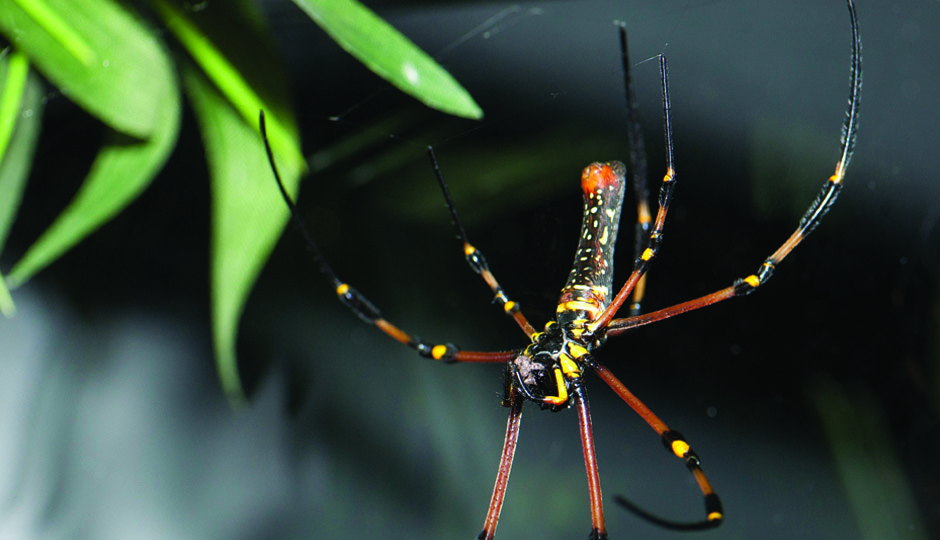Spiders are Here for the Summer!
Come to Spiders Alive! at the Museum of Science this summer. Creepy, crawly, and apt to send shivers down your spine, spiders might have you wondering, “what’s to like?” The answer: quite a bit! These members of the class Arachnida have been scuttling around for more than 300 million years. They inhabit every continent but Antarctica. The more than 44,500 known species are important predators keeping the insect population down and have fascinating traits and behaviors. Learn about their amazing attributes and more with Spiders Alive!, a temporary exhibition coming to the Museum June 12.
For the first time almost anywhere
Find out about spiders’ anatomy, evolutionary history, and signature traits such as venom and silk-making from this exhibition featuring live spiders, larger-than-life models, and videos. Spiders Alive! was a big hit during its two runs at New York City’s American Museum of Natural History (AMNH) and has never been seen anywhere else—until now!
Dispelling the myth
According to its creators, “the exhibition will focus on debunking spider myths such as that spiders need gravity to build webs, that all spiders neglect their offspring, and that all spider bites are harmful to humans.” The exhibition features approximately 20 species of arachnids, including 16 spiders, two scorpions, a vinegaroon, and an African whip spider. Museum staff will highlight some of the fascinating aspects of the structure and behavior of spiders through interactive demonstrations.
Variety on display
Among the species you’ll see:
The Ornamental Tarantula
As colorful as any tropical bird,
The Fishing Spider
Rests its front legs on the surface of the shoreline to sense vibrations from the prey before pouncing for the kill
The Desert Hairy Scorpion
Feeds on a variety of species, including the occasional small mammal!
The Goliath Bird Eater
One of the world’s largest spiders, which despite its name, rarely eats birds, but enjoys a menu of insects, small frogs, lizards, and mice.
Venomous western black widow
Easily identifiable by the red hourglass shape on its underside, the giant vinegaroon that shoots a foul-smelling spray from its abdomen when disturbed, and the orb weaver, the inspiration for the title character in the classic children’s book Charlotte’s Web.
Larger Than Life!
The exhibition also showcases larger-than-life models of spiders, including one you can climb, and a rare 100-million-year-old fossil.
Videos
Watch intriguing videos, including one about a field exhibition to study goblin spiders in Ecuador and another with spiders living underwater, spinning silk, constructing webs, and more.
If you’re the type that gets giddy about spiders, this is obviously the exhibit for you. But even if you’re one who gets skittish when those eight legs come crawling, this is your chance to overcome your arachnophobia in a friendly and safe environment—and find out what makes these animals so intriguing. Come to Spiders Alive!, opening June 12 for a limited engagement.
Arachna-facts
- Although many people refer to spiders as insects, they are not. Insects have six legs, a three-part body, antennae, often wings, and compound eyes. Spiders have eight legs, a two-part body, no antennae or wings, and simple eyes.
- All spiders can produce silk, although less than half use that ability to construct webs. The silk is a protein formed as a liquid by silk glands and squeezed out of organs known as spinnerets.
- The Darwin’s bark spider of Madagascar makes the world’s largest known webs, according to National Geographic. Webs as wide as 82 feet have been found!
- Spiders are nature’s population controllers. On one acre of woodland alone, spiders can consume more than 80 pounds of insects in a year. Just imagine what a world without them would look like!
Spiders Alive! is organized by the American Museum of Natural History, New York (amnh.org).
http://www.mos.org/exhibits/spiders-alive
This is a paid partnership between Museum of Science and Boston Magazine



